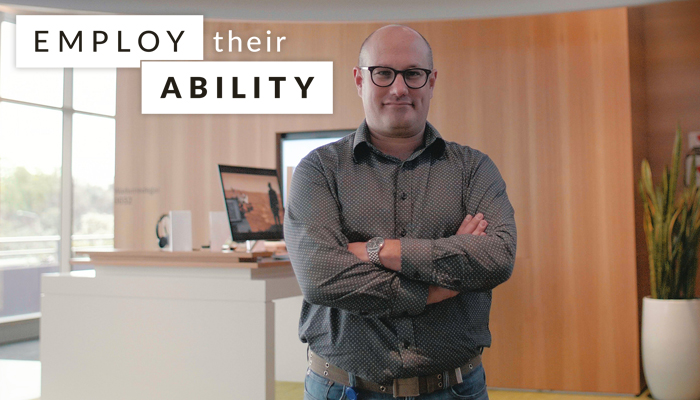Supporting employee wellbeing in office and remote working environments

Image: a person standing in front of a window and desk in the office.
The swift change in the way we work and live, combined with the sense of uncertainty brought about by the COVID-19 pandemic is likely to affect everyone in different ways.
For employers, to support and collaborate with their teams while ensuring mental well-being has never been more pertinent.
Studies have found employers who show their commitment to developing a mentally healthy workplace reap long-term rewards. These include lower absenteeism rates, higher productivity and an increase in employee trust and confidence1. But, how does this translate when employees are working from home?
To answer this and discuss the range of supports employers can tap into, JobAccess organised a free webinar for employer partners and alumni of the National Disability Recruitment Coordinator (NDRC).
More than 60 employers representing public and private-sector organisations joined the online event to hear strategies for managing mental health and supporting employees, whether in the office or home environment.
Poor mental health has a high cost
JobAccess General Manager, Daniel Valiente-Riedl shared with employers the high probability they may already be employing people with mental health conditions and not be aware of it.
“At least 45 per cent of us will experience a mental disorder at some stage in our lives2, which makes it all the more important for employers to promote a positive workplace culture,” he said.
Daniel emphasised the high cost Australian employers incur due to the impacts of a mentally unhealthy working environment.
“Untreated mental health conditions cost employers AU$10.9 billion every year through absenteeism, reduced productivity and compensation claims,” he said, citing a PwC report3 on mental health in the workplace.
Resources to support employee mental health
Camille Greenwell, Client Support Manager (Workplace Modifications and Training) at JobAccess, urged employers to be clear about the intent behind starting a conversation with an employee who is identified as having a mental health condition.
“If someone’s diagnosis is impacting on their ability to do their job, it is appropriate to have a discussion with the employee.
You might like to offer for an employee to have a support person with them. Remember, always be clear of the issues and have concrete examples of similar experiences or supports readily available,” she said.
Camille also explained the supports employers can utilise through JobAccess.
“The Employment Assistance Fund (EAF) provides employers with funding of $1,500 per annum for each eligible employee to conduct training at the workplace by qualified professionals with specialist expertise.
The training is designed to equip organisations with skills to manage common mental health problems at work effectively,” Camille said.
Funding is also available for specialist services provided by professionals with expertise in the areas of mental health, including learning disorders.
How to support employees to work from home
Camille also shared strategies for employers to support employees while they are working from home, both over the short-term or as part of an ongoing work arrangement.
“It is essential employers take time to check-in with employees to see how they are managing their working from home arrangements. You should also maintain and schedule social events as they would typically occur in the office environment, such as celebrating company or individual milestones.”
Encouraging the need to have an open mindset when it comes to flexibility, Camille explained, “Employers need to consider that each employee’s circumstances may be different. As such, some may require different start and finish times due to their condition or having the responsibility of being a carer.
Have an open discussion with your employees and find a mutually agreeable working arrangement while setting reasonable expectations on deliverables.”
If an employee with disability, including mental health conditions, is required to work from home due to their condition on an ongoing basis, employers can contact JobAccess to organise adjustments which may be available through the Employment Assistance Fund.
Other support services for mental health advice
- Head to Health can help you find digital mental health services from some of Australia’s most trusted mental health organisations. Provided by the Australian Department of Health, Head to Health brings together apps, online programs, online forums, and phone services, as well as a range of digital information resources.
- Beyond Blue offers support services, programs, research, advocacy and communication activities to break down the stigma, prejudice and discrimination that act as barriers to people reaching out for mental health support. Beyond Blue is offering specific COVID-19 advice and information through the Coronavirus Mental Wellbeing Support Service.
- Black Dog Institute is an independent, not-for-profit medical research institute designed to investigate mental health across the lifespan. They have a range of resources to help manage anxiety and stress arising due to the COVID-19 pandemic.
- MindSpot is another free service for Australian adults who are experiencing difficulties with anxiety, stress, depression and low mood.
Sources:
1 The State of Workplace Mental Health in Australia. Beyond Blue. http://headsup.org.au/docs/default-source/resources/bl1270-report---tns-the-state-of-mental-health-in-australian-workplaces-hr.pdf?sfvrsn=8
2 Fact vs myth: mental illness basics. SANE website. https://www.sane.org/mental-health-and-illness/facts-and-guides/fvm-mental-illness-basics.
3 Creating a mentally healthy workplace - return on investment analysis. Heads Up. https://www.headsup.org.au/docs/default-source/resources/beyondblue_workplaceroi_finalreport_may-2014.pdf
Last updated:
